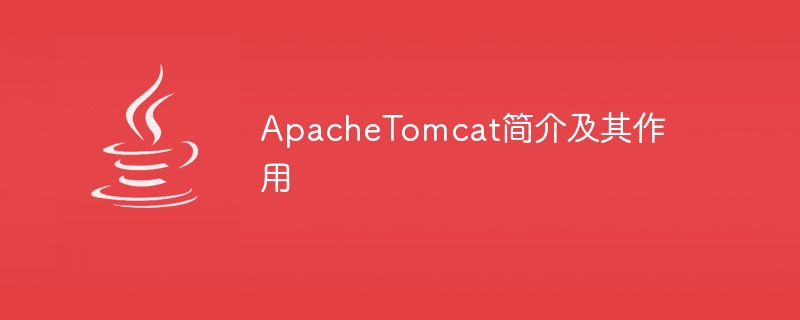A brief introduction to Apache Tomcat and its functions

Introduction to Apache Tomcat and its role
Apache Tomcat (also known as Tomcat) is an open source Java Servlet container, which is a sub-project of the Apache Software Foundation . Tomcat is currently one of the most popular open source Java Web application servers and can be used to run Java Servlets, JavaServer Pages (JSP) and other Web applications.
Tomcat is a server software. Its main function is to connect the Web server and the application server. It can parse and execute Servlets and send dynamically generated pages to the client. It follows the Java Servlet, JavaServer Pages and Java WebSocket specifications and provides a runtime environment that enables developers to easily create and deploy Java Web applications.
Tomcat's architecture is component-based, using a core container called Catalina, which is responsible for processing requests for web resources and passing them to the appropriate processor components. Catalina is also responsible for managing the life cycle of servlets and other web application components.
The main features of Tomcat include:
- Easy to install and configure: Tomcat can be installed and configured on a variety of operating systems (including Windows, Linux, macOS, etc.). It provides a simple startup script, making deployment and maintenance very easy.
- High performance: Tomcat is a lightweight container with fast startup time and response time. It can handle large numbers of concurrent requests and provides a highly scalable architecture.
- Security: Tomcat provides some security features, such as SSL/TLS support, access control, authentication and authorization, etc. Developers can use these features to protect web application data and resources.
- Open Source: Tomcat is an open source project, with a large number of developers and users in the community contributing various features and improvements. This makes Tomcat a reliable and stable web server.
The following is a simple Tomcat example that shows how to use Tomcat to run a simple Servlet program:
import java.io.*;
import javax.servlet.*;
import javax.servlet.http.*;
public class HelloWorldServlet extends HttpServlet {
public void doGet(HttpServletRequest request, HttpServletResponse response) throws ServletException, IOException {
response.setContentType("text/html");
PrintWriter out = response.getWriter();
out.println("<html>");
out.println("<head>");
out.println("<title>Hello World Servlet</title>");
out.println("</head>");
out.println("<body>");
out.println("<h1 id="Hello-World">Hello World!</h1>");
out.println("</body>");
out.println("</html>");
}
}To run this Servlet in Tomcat, you first need to compile it and The compiled .class file is placed in Tomcat's webapps directory. Then, start the Tomcat server and execute the Servlet by accessing http://localhost:8080/HelloWorldServlet.
To summarize, Apache Tomcat is a powerful, easy-to-use and high-performance Java Servlet container that provides a running environment to deploy and run Java Web applications. With Tomcat, developers can easily build flexible, scalable and secure web applications. Whether you are a beginner or an experienced developer, Tomcat is an excellent tool worth learning and using.
The above is the detailed content of A brief introduction to Apache Tomcat and its functions. For more information, please follow other related articles on the PHP Chinese website!

Hot AI Tools

Undresser.AI Undress
AI-powered app for creating realistic nude photos

AI Clothes Remover
Online AI tool for removing clothes from photos.

Undress AI Tool
Undress images for free

Clothoff.io
AI clothes remover

AI Hentai Generator
Generate AI Hentai for free.

Hot Article

Hot Tools

Notepad++7.3.1
Easy-to-use and free code editor

SublimeText3 Chinese version
Chinese version, very easy to use

Zend Studio 13.0.1
Powerful PHP integrated development environment

Dreamweaver CS6
Visual web development tools

SublimeText3 Mac version
God-level code editing software (SublimeText3)

Hot Topics
 1378
1378
 52
52
 How does Java's classloading mechanism work, including different classloaders and their delegation models?
Mar 17, 2025 pm 05:35 PM
How does Java's classloading mechanism work, including different classloaders and their delegation models?
Mar 17, 2025 pm 05:35 PM
Java's classloading involves loading, linking, and initializing classes using a hierarchical system with Bootstrap, Extension, and Application classloaders. The parent delegation model ensures core classes are loaded first, affecting custom class loa
 How do I implement multi-level caching in Java applications using libraries like Caffeine or Guava Cache?
Mar 17, 2025 pm 05:44 PM
How do I implement multi-level caching in Java applications using libraries like Caffeine or Guava Cache?
Mar 17, 2025 pm 05:44 PM
The article discusses implementing multi-level caching in Java using Caffeine and Guava Cache to enhance application performance. It covers setup, integration, and performance benefits, along with configuration and eviction policy management best pra
 How can I use JPA (Java Persistence API) for object-relational mapping with advanced features like caching and lazy loading?
Mar 17, 2025 pm 05:43 PM
How can I use JPA (Java Persistence API) for object-relational mapping with advanced features like caching and lazy loading?
Mar 17, 2025 pm 05:43 PM
The article discusses using JPA for object-relational mapping with advanced features like caching and lazy loading. It covers setup, entity mapping, and best practices for optimizing performance while highlighting potential pitfalls.[159 characters]
 How do I use Maven or Gradle for advanced Java project management, build automation, and dependency resolution?
Mar 17, 2025 pm 05:46 PM
How do I use Maven or Gradle for advanced Java project management, build automation, and dependency resolution?
Mar 17, 2025 pm 05:46 PM
The article discusses using Maven and Gradle for Java project management, build automation, and dependency resolution, comparing their approaches and optimization strategies.
 How do I create and use custom Java libraries (JAR files) with proper versioning and dependency management?
Mar 17, 2025 pm 05:45 PM
How do I create and use custom Java libraries (JAR files) with proper versioning and dependency management?
Mar 17, 2025 pm 05:45 PM
The article discusses creating and using custom Java libraries (JAR files) with proper versioning and dependency management, using tools like Maven and Gradle.




